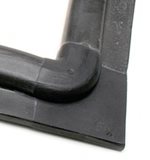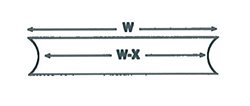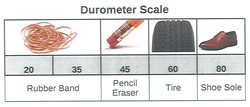Custom Molded Rubber Gaskets | Custom Molded Rubber Seals
Designing a custom molded rubber seal or gasket involves three steps:
- Understanding the need for a molded rubber gasket.
- Determining the proper compressive force.
- Understanding the environment in order to select the correct material.
1. Understanding the Need for a Molded Rubber Gasket
Custom molded rubber gaskets offer a lot of advantages over other types of gaskets and seals, but they are generally more expensive than extruded gaskets or die cut gaskets. In general, if the application can be sealed with either of the other two options, that is the direction to take.
Interested in learning more about gaskets and seals? Our blog post breaking down the subtle
differences between gaskets and seals can help.
Can the gasket be extruded? In cases where the profile or cross-section of the gasket does not change along its entire length, an extruded gasket may work. Keep in mind that one disadvantage of extruded gaskets is the existence of a splice (in cases where the gasket is round) or more than one splice (in cases where the extrusion is cut to length and spliced - either 45 degree splices or spliced to corner molds). Splice joints are typically not as strong as the material itself and can potentially provide a leak path if not done properly. Below is a picture showing splice seams on a corner splice.
 Can the gasket be die cut?
Can the gasket be die cut? In cases where the gasket is a uniform thickness with no contours, a die cut gasket may work. Keep in mind that sometimes, if the part is too thick or the size of contours is too small when compared to the thickness, a die cut gasket may not be possible.
Another limitation of die cut gaskets is thickness tolerance - we have seen instances where a molded gasket with tighter thickness tolerances was necessary given the stack-up height and components in the mating parts.
Finally, die cut gaskets that are more than 0.125" thick will likely have a dished shape along the edges and the thicker the material, the more pronounced the dish shape will be. "As shown in the drawing below, the 'dish' effect is a concavity of die-cut edges (due to the squeezing of the material by the pressure of the cutting die). The width 'W' (or length) at the top and bottom surface are slightly greater than the width 'W-X' at the center." Figure 30. ARPM Handbook.
 Custom Molded Gaskets
Custom Molded Gaskets Below lists some of the advantages molded rubber gaskets have over both extruded and die cut gaskets:
- Three dimensional geometry is possible
- Tighter dimensional tolerances
- No splices - parting lines can be designed to minimize leak paths
- Special engraving is possible on the visible surface of the gasket - textures, logos, etc.
2. Determining the Proper Compressive Force
All rubber seals and rubber gaskets work because they are compressed between two mating components. The compressive force required to seal is dependent on the pressure and particle size (air, water or oil) that is being sealed. The higher the pressure and/or smaller the particle size, the higher the compressive force on the gasket will have to be.
There are three related material properties that also effect the designed compressive force:
- Compression Set - A measure of rubber's tendency to lose its "bounce-back" capabilities after being compressed for a period of time.
- The most common test is ASTM D395, which involves a test sample approximately 0.500" thick that is compressed down to 0.375" thick and held in that state for either 22 or 70 hours in a 158F - 300F oven. After baking, the sample is removed from the oven and the compression fixture and thickness is measured after 30 minutes of cooling. CB, the compression set B is given by CB = [(to - ti) / (to - tn)] * 100 where to is the original specimen thickness, ti is the specimen thickness after testing and tn is the spacer thickness or the specimen thickness during the test.
- Materials with low compression set values generally do not make good seals or gaskets because after time, they conform to the mating parts whcih can result in a leak path.
- Stress Relaxation - The pressure loss over time as the rubber "adjusts" to its compressed state. In the description above of Compression Set, if one were to measure the force required to compress the sample down from 0.500" thick to 0.375" thick, the pressure required to do so would decline over time. An instance such as this is considered Stress Relaxation.
- Creep - Simplistically, creep is a combination of the two terms listed above. There are more techical explanations for Creep (and the other terms) in materials science text books.
Materials can be formulated to minimize Compression Set, Stress Relaxation, and Creep. As with all physical properties, when one or two characteristics are improved, other characteristics have to be compromised.
In addition to the dynamic reaction of rubber to the assembly that is described above, there are two more simplistic variables that can also affect the designed compressive force required.
- Durometer (or hardness) - Measured on the Shore A scale for rubber materials. The lower the durometer (softer material), the lower the compression force will be on the assembly. This is important if the mating features are delicate. The trade off is that lower durometer rubber materials typically have lower values for compression set, stress relaxation and creep.

- Geometry - The variable that can often be overlooked, but opens up the design possibilities when gaskets and/or seals are molded. By changing the design (adding chevron features, sealing beads or lip-seal features), molded rubber gaskets can take advantage of geometry to seal complicated mating parts with minimal compression force. Below is a great example of a complex seal for one of the first handheld GPS units.

3. Understanding the Environment to Select the Correct Material
Selecting the right material for a molded gasket or molded seal is important. Custom Rubber Corp. can help pick the material that is the most cost effective for your application.
Rubber Materials for Molded Gaskets and Molded Seals
| MATERIAL |
ABBREVIATION |
COMPRESSION SET @ 158F |
OZONE & UV RESISTANCE |
TEMPERATURE RANGE |
GAS PERMEABILITY |
RELATVIE PRICE |
| Ethylene-Propylene |
EPDM |
Good |
Excellent |
-70F to 250F |
Fair |
Excellent |
| Nitrile |
NBR |
Excellent |
Poor |
-30F to 250F |
Fair |
Good |
| Neoprene / Chloroprene |
CR |
Fair |
Good |
-60F to 220F |
Fair |
Excellent |
| Silicone |
VMQ |
Excellent |
Excellent |
-175F to 450F |
Good |
Fair |
| Natural |
NR |
Good |
Poor |
-60F to 220F |
Fair |
Fair |
None of the parts pictured are in stock or for sale. These are all examples of custom-manufactured products that illustrate Custom Rubber Corp.'s capabilities.